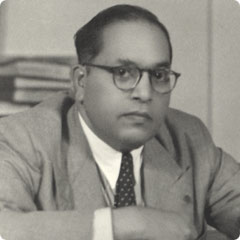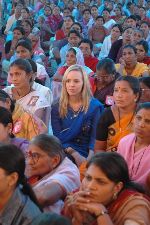 Think of an Indian politician - chances are if you are a Westerner you either thought of Gandhi or one of his scions. I usually don't like to write about politics or politicians since it only seems to encourage them. In this case however there is a definite tie in with Buddhism in India, so I'll break my own rule just this once.
Think of an Indian politician - chances are if you are a Westerner you either thought of Gandhi or one of his scions. I usually don't like to write about politics or politicians since it only seems to encourage them. In this case however there is a definite tie in with Buddhism in India, so I'll break my own rule just this once.Now if I asked an Indian Buddhist the same question they would most likely not think of a Gandhi, they would be more likely to think of Dr. B.R. Ambedkar. In fact if you asked them about Gandhi they might be quit dismissive of him - which can come as a bit of a shock to those who think of him as a kind of saint who did so much for the oppressed people of Indian. So why would an Indian Buddhist think like this?
The simple answer is this: caste. Caste is the system of social stratification which goes back a 100 generations in India. It attained the status of immutable law early in this era, and is still central to Indian society. Most Indian Buddhists were born into social circumstances, i.e. into a caste, which not only oppressed them, but tried to cut off any escape routes. Caste is strongly linked to the Hindu idea of karma - which has similarities and differences from the Buddhist idea. The main thing here is that one's station in life is determined by the caste one is born into, and that is determined by actions in a past life. If one is born into poverty, oppression, poor health, and few opportunities, then one must deserve it, and one must accept it as one's lot. Clearly this ideology could only have been thought up by a privileged elite. Some castes were thought to be so low down the evolutionary scale, to have committed such heinous crimes in their past life and so brought penury upon themselves, that the mere touch of them polluted a higher caste Hindu - they were the untouchables.
Dr Ambedkar was born into the Mahar caste and at that time the Mahars were untouchable. This typically meant that they were forced to do the dirtiest, lowest paid, most dangerous jobs, denied education, and oppressed in various other ways. Ambedkar managed to escape his fate. Ambedkar found a liberal and philanthropic mentor and sponsor who paid for his education. Mind you he still suffered severe prejudice - and famously had to sit outside the classroom of his primary school listening to lessons through the window. Ambedkar persevered and eventually gained a doctor of law degree from Harvard University. He went on to become the first law minister of India in the Gandhi lead government. Ambedkar was the architect of the constitution of India, and importantly for his people succeeded in the abolition of untouchability.
Clearly Ambedkar was a great man who inspired his people to raise themselves out of the dirt. But why the antipathy towards Gandhi? Gandhiji opposed Ambedkar's desire to free all Indians from caste. Ambedkar proposed abolishing caste altogether, but Gandhi resisted him. He even went on one of his famous hunger strikes to force Ambedkar to back down and water down his anti-caste legislation. Gandhi believed that caste was what held Indian society together. He wanted to maintain caste duty for Hindus which meant dirty hard labour for the untouchables, but to show that it wasn't personal he suggested changing their designation from untouchables to harijans or "children of god". Gandhi spoke out against oppression, against religious intolerance, but he also supported the status quo of the caste system. Gandhi was a Brahmin. The cynical would simply say that was protecting the interests of his caste, or perhaps that he knew that high caste power brokers in India would not accept the ex-untouchables as equals.
1949 came and India became independent and the people formerly known as untouchables did begin to be able to make a few changes. But caste prejudice persisted and the uplift of the oppressed people was resisted. Ambedkar decided that Hindu prejudice against them was too strong. After lengthy consideration he became a convert to Buddhism, and led millions of his people to abandon Hinduism and embrace the Buddhadharma. This did not end the prejudice however nor the persecution, but it helped to give these oppressed people a vision of freedom for themselves and their children.
People who are born into those communities which were formally designated as untouchable, now refer to themselves as Dalit - oppressed. The Dalits revere Ambedkar as a bodhisattva, as a saviour who showed them how they could be free. They don't revere Gandhi because Gandhi was unwilling to treat them as equals. Attacks on Dalits continue to be common place in part so India. On 26 September 2006 Ambedkar's home state of Maharastra was rocked by the brutal rape and murder of the family of a Dalit man. The attack was allegedly committed by high caste Hindus in revenge for his opposition to the building of a road through his fields, and sparked a series of protests and strikes in the State.
October the 14th 2006 marked 50 years since the conversion of Dr Ambedkar to Buddhism. His followers greet each other with Jai Bhim! which means Victory to Bhimrao (Ambedkar)!
I recommend the BBC radio program Escaping Caste

